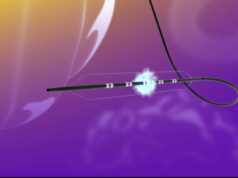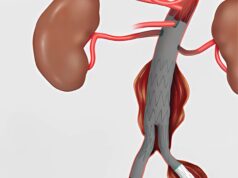The Society for Vascular Surgery (SVS) presented its highest honour, the Lifetime Achievement Award, to Wesley S Moore during the Vascular Annual Meeting held in June.
A leader in vascular surgery, Moore was the youngest vascular surgeon to be elected SVS president (1986). As chief of Vascular Surgery at the University of Arizona and the University of California Los Angeles (UCLA), Moore has mentored countless young vascular surgeons. He founded and led UCLA’s vascular fellows and residents course for 25 years. He has authored 300 peer-reviewed articles, 200 book chapters, and edited or authored 15 vascular textbooks or monographs.
Moore is a pioneer in the development of prosthetic vascular grafts, the treatment of graft infections, lower extremity bypass procedure improvements, and endovascular treatments. He was the first vascular surgeon to place an FDA-approved endograft in an abdominal aortic aneurysm patient. He was also one of the key vascular surgeons involved in the Carotid Revascularization Endarterectomy vs. Stenting Trial (CREST).
Who were the physicians who influenced you most during your career?
I was most influenced by three surgeons. They were, in the order of contact, H Glen Bell, F William Blaisdell, and Albert D Hall. Dr Bell was formerly chairman of the Department of Surgery at the University of California, San Francisco (UCSF). I met him and worked on his service when he was retired from that position, but continued to operate and take care of patients as Professor Emeritus. I learned from Dr Bell several things which include predictability; I knew when he wanted to make rounds, I knew that he would always be the first person in the operating room, and I learned from him how to communicate and relate to patients.
Dr Blaisdell was my programme director and chief of Surgery at the VA Hospital in San Francisco when I started my surgical training. He was young, energetic, and highly charismatic. Vascular surgery was in its infancy at that time and he brought to our programme knowledge and experience that he gained as a fellow in Houston under the guidance of DeBakey, Cooley, and Crawford. That experience influenced our programme and I was determined, as a result, to become a vascular surgeon. It would be difficult to overstate the influence that he had on my career as an academic vascular surgeon. If it were not for him, I would not be writing this piece today. When I finished my vascular surgery training, Dr Albert Hall was chief of Surgery at the San Francisco VA Hospital, one of three teaching hospitals in the UCSF surgical programme. Dr Hall was a master surgeon of great intellectual depth. He taught me many things including careful planning and preparation for any operative procedure as well as considering options that others might not consider. I am grateful to him for offering me my first academic position as chief of Vascular Surgery at the San Francisco VA where I spent the next 10 years. Those were exciting times at UCSF where J Englebert Dunphy was professor and chairman.
What has your most memorable case been?
This is a hard question to answer as there have been many exciting cases over the years. Perhaps one of the most memorable and historically important cases occurred when I was a second year resident in 1962. Two days earlier I had helped our chief resident do an abdominal aortic aneurysm repair on a patient who was also an above-knee amputee. The patient initially had an uneventful course until the morning of the third post-operative day when he thrombosed his graft resulting in profound ischaemia. We rushed him back to the operating room and with the induction of anaesthesia, he suffered a cardiac arrest. Closed chest resuscitation had just been introduced and we were able to get his heart started.
However, we were now faced with a patient who had just suffered a cardiac arrest who had a thrombosed aortic graft and clearly would not tolerate an abdominal operation. At this point we called Dr Blaisdell into the room for his advice and help. He considered the problem, went into his office for a few minutes to think and then returned to the operating room having invented the concept of the axillo-femoral bypass. Using local anaesthesia we exposed the patient’s right axillary and femoral arteries. At that time, no tunneling devices had been invented, so we used the longest instrument we had which was an external ring vein stripper. Using that instrument, we created a tunnel for the graft. The result was restoration of lower extremity blood flow. That patient survived with a patent graft for the next five years.
Has CREST answered the question on the use of carotid artery stenting?
CREST has been an extremely important trial. The results are still being analysed and many derivative papers are yet to be published. The initial publication, in which the three primary endpoints of death, stroke, and myocardial infarction were reported in aggregate, indicated that there was no statistically significant difference between carotid endarterectomy and carotid angioplasty/stenting. However, when the traditional endpoints of death and stroke were analysed separately, stenting had twice as many strokes as endarterectomy. Even though endarterectomy had more myocardial infarctions, the survival rates of endarterectomy and stenting patients were identical because both stroke and myocardial infarction had an equally adverse effect on survival. While interventionists will point to the aggregate endpoint results, vascular surgeons will point to endarterectomy as a safer procedure with fewer disabling stroke events. This controversy and selective interpretation of results is likely to continue.












